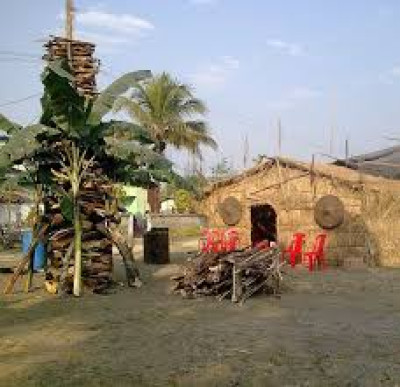Bhelaghar Of Magh Bihu In Assam: Tradition, Celebration, And Community Feasts.



A Bhelaghar is a temporary hut or shelter constructed by the local community during Magh Bihu, particularly on the eve of the festival, known as Uruka. These huts are made using natural materials like bamboo, thatch, straw, and dried leaves. Young men and women in the villages gather to build these structures, combining skill, teamwork, and tradition. The Bhelaghar is not just a shelter but a focal point for social gatherings, feasting, and community bonding.
The construction process is a community affair. Bamboo poles are used to create the framework, while straw, dried leaves, and thatch cover the walls and roof. The construction is both functional and symbolic, representing the simplicity and resourcefulness of Assamese rural life. Despite being temporary, Bhelaghars are sturdy enough to accommodate large groups of people for feasting and celebration on Uruka night.
The primary purpose of a Bhelaghar is to provide shelter and space for communal feasting. During Uruka, families and neighbors gather in these huts to share food, sing traditional songs, and perform rituals. The Bhelaghar serves as a temporary night shelter and a community dining hall where everyone, young and old, participates in the merriment. The hut reflects the spirit of togetherness and cultural unity that defines Magh Bihu.
Food plays a central role in Magh Bihu celebrations, and Bhelaghars become the heart of culinary festivity. Traditional Assamese dishes such as pithas, larus, and various rice preparations are prepared and shared among community members. The feasting inside the Bhelaghar is accompanied by folk music, dancing, and socializing, making it a vibrant cultural experience.
Beyond its practical use, the Bhelaghar carries deep cultural significance. It represents the harvest, prosperity, and unity of the community. The temporary nature of the hut also reminds participants of the transient joys of life and the cyclical nature of agricultural existence. Its eventual burning symbolizes renewal and the conclusion of one harvest season, making way for the next.
On the morning after Uruka, the Bhelaghar is traditionally set on fire along with the Meji, a large bonfire built as a ritual offering. This act marks the end of the festival, signifying purification, prosperity, and new beginnings. The burning ceremony draws everyone together once again, reinforcing community bonds and celebrating the success of the harvest.
Bhelaghars are more than mere huts; they are a living symbol of Assamese heritage. They preserve age-old customs and collective traditions, teaching younger generations the value of teamwork, sharing, and cultural continuity. In many villages, the construction of Bhelaghars has become a rite of passage for youth, blending fun with tradition and instilling a sense of pride in cultural identity.
While traditional materials are preferred, some urban areas now use modern materials or semi-permanent structures to create Bhelaghars. Despite changes in construction methods, the spirit of the festival remains unchanged. Communities still gather to cook, feast, sing, and dance, preserving the essence of Magh Bihu in contemporary Assam.
For visitors and tourists, witnessing the construction of a Bhelaghar and participating in Uruka feasts offers a unique insight into Assamese culture. The sights, sounds, and aromas create an immersive experience of rural life and agricultural celebrations. The communal joy, rustic hospitality, and traditional music make Bhelaghar a highlight of Assam’s cultural calendar.
The Bhelaghar of Magh Bihu is more than a festival hut—it embodies the spirit of community, tradition, and celebration in Assam. From construction to feasting and finally the ceremonial burning, every aspect reflects Assamese culture, agricultural prosperity, and social unity. Celebrating Magh Bihu around the Bhelaghar is an experience that continues to connect generations, preserve heritage, and bring joy to communities across Assam.